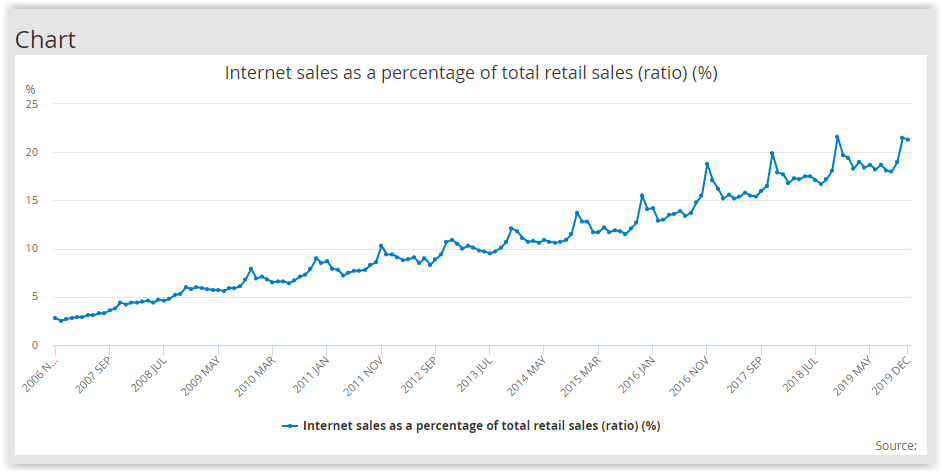August Round-up: Better Meta Targeting, Google Glitch & UX Best Practice
The latest version of our newsletter should have settled in your email inbox, detailing the need-to-know information and must-read thought leadership...
Read moreIn my latest article I delve into E-commerce growth and how your business can harness this to its full potential.
For many years, growth in e-commerce sales has been a given as consumers have been attracted to the convenience and cost-savings of buying online.
Yet this organic source of growth from consumer adoption of new digital devices has been declining for some time as those responsible for e-commerce activities for their brands will be acutely aware. It was never going to last and there are already signs that it is declining. Multichannel retailers have also had to contend with cannibalisation of offline sales by online purchases, although this may be offset to some degree when "click and collect" purchases are factored-in.
The latest ONS E-commerce growth data for the UK charts the increase in proportion of online sales from less than ten percent ten at the start of the last decade to approaching twenty percent at the end.

Although there is still an upward trend, looking at the Black Friday spike, in November 2019, the percentage of online sales (21.5%) was below the 21.6% figure for November previous year for the first time ever.
In the initial years of online retail sales, e-commerce growth was driven by new consumers buying for the first time and merchants opening up their stores. In more recent years, most of the increase has been from consumers buying in new categories and changing their behaviour to purchase more frequency.
Looking at online purchase frequency across categories shows that many people are now buying over 10 times over a three month period.
There will be some further growth as less frequent purchasers become more confident, but for significant growth changes will need to be made to make retailers and brands more competitive.
Future success in achieving growth in e-commerce sales will require a change in mindset to maximise new, incremental growth opportunities that are not dependent on an increase in online buyers and purchase frequency.
At ClickThrough Marketing, our regular customer reviews focus on these opportunities for growth considering changes in demand for consumers for online purchase intent across different categories.
Most businesses will naturally have been working on the activities that will drive incremental growth in order to hit their revenue and profit targets, but to become more competitive in the future warrants a review of your growth drivers. Here are some of the key questions to ask.
To review the drivers of growth means going back to basics by reviewing customer engagement across the full customer lifecycle. We recommend that as part of your strategic planning approach you complete a health check reviewing the efficiency and effectiveness of all tactics. Here is a free high-level benchmark I created for Smart Insights across the main parts r RACE planning framework available as a download here.
In a follow-up article I'll drill down to look at some of the practical opportunities for improvements across these areas in the year ahead. In terms of a mindset, having an agile approach to review trading performance and making improvements is essential. All retail businesses have trading reviews considering sales and merchandising performance across different categories, but not all have a planned approach to optimising existing always-on capabilities. For example, is there a regular programme for AB testing different page templates across the customer journey, are email communications optimised on a continuous basis.
In a previous article on this blog I suggested reviewing your capabilities to deliver on improvements in tactics by evaluating these investments.
Media:
Grow awareness through integrating paid, owned, and earned media.
Customer experience:
Optimise websites, apps, company social media pages and how they integrate with customer-facing sales and support staff to engage, explain, and convert.
Messaging or ‘conversation marketing’:
Deploy personalized communications to welcome, educate, and nurture prospects and customers across websites, email marketing, and mobile notifications.
Content marketing:
Create quality, sector-leading content to fuel all your marketing activities from search to social to email marketing.
Marketing governance or management:
These are the resources needed to develop strategies, action plans, resources, budgets, and KPI dashboards to test, learn, refine, and integrate all marketing and sales communications.
The research I reported on showed that many don't have basic planning or review capabilities in place. Plus a major omission was a martech roadmap reviewing the suitability of the martech stack to drive growth through its features.
Across all of these potential drivers for growth that I will talk more about in my next article, prioritisation is essential. This means creating a long-term roadmap of improvements that you need to make with some identified as quick wins and others that will require new investments in marketing technology.
If you score your use of these tactics compared to competitors in your sector in the benchmark above, you can identify improvements to focus on that will give the biggest returns. Researching loyalty drivers amongst existing customers can also help with prioritisation.
Want to find out more? Get in touch with the experts at ClickThrough to discuss your business' E-commerce growth in further detail.
More articles you might be interested in:

The latest version of our newsletter should have settled in your email inbox, detailing the need-to-know information and must-read thought leadership...
Read more
As the cost of living continues to present challenges for many Brits, an increasing number of families are choosing to holiday within the United...
Read more
Our first curated newsletter has hit inboxes, detailing all of the latest need-to-know information and sharing all the necessary thought leadership...
Read more
Over the past few years, marketing leaders have been gearing up for the inevitable 'Cookieless Future'. Safari was the first to bid farewell to...
Read more.png)
It only seems like yesterday that it was the winter of 2022 and we were balancing Black Friday and the Qatar World Cup. Fast forward to now and we're...
Read more
There are many factors to consider when choosing an automotive dealership, with 53% of customers saying that price determines which dealership they...
Read more
Which UK-based private healthcare providers are running away with their digital presence and who needs a helping hand to take the next step? How is...
Read more.jpg)
How prepared are you for planning & budgeting season? Dave Chaffey shares some of the questions you should ask yourself when planning marketing...
Read more